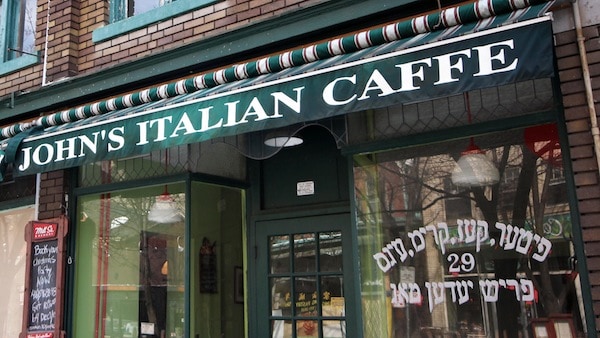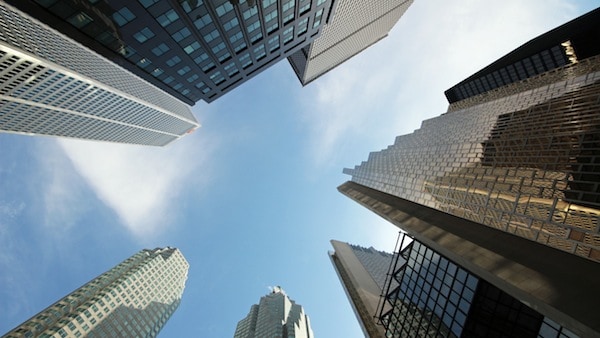Toronto recently celebrated its one hundred and eightieth birthday. I have lived here all my life, but I’m always surprised when reminded of the city’s age; looking around, there is little to suggest that it predates confederation. It grew in shaky steps as more and more plots of fertile lakebed farmland were paved, built on, and tunnelled under. Over the decades, we’ve razed entire slums and industrial districts and, more recently, we’ve reinvented blocks with new roles and relevance.

Greek street signs on the corner of Danforth and Carlaw. ADAM ZACHARY/THE VARSITY
Toronto has grown as a collection of neighbourhoods, or villages, that are exquisitely distinct yet governed by a central power. As such, ours has become a city with no one, coherent, internal identity. There is little beyond proximity that links Forest Hill to Kensington, or the downtown maze of towers to the placid Beaches.
Our experience of the city is totally informed by which subway stop we come home to at night, which corner store we buy our cigarettes at, whether we wake up in a glassed-in high-rise or a bay-and-gable basement. In adult life, others’ opinions of us will be founded upon the answer to that question; we, too, may in part define ourselves by it. We perceive neighbourhoods based on their outstanding traits such as their ethnic communities, architectural styles, and unique landmarks. These are the traits that both make up and display their character. How the rest of the world sees Toronto is equally informed by this patchwork identity.
Cultural lines
Last month, The New York Times’ travel section characterized Toronto as an “ethnic buffet” — a city of overlapping neighbourhoods, full of immensely different populations that live calmly side by side. The article made me wonder if tourists visit Toronto not to see Toronto, but to, for example, go dancing on Church Street or shop in Yorkville. We, as residents, have this psychology; the high school experience in this town is coloured by day trips to Kensington and nights spent sneaking into Annex bars.

How Toronto came to be this way is not easily understood, but one important element is the different immigrant populations that settled in different areas of the city through the nineteenth and early twentieth centuries. A common trend in the movements of these populations was to start in a place once known as The Ward. This was bound by Queen Street West, University Avenue, Dundas Street West, and Yonge Street — we know this as a built-up northern stretch of downtown, but it once housed the city’s largest and most notorious slum.
Irish, Jewish, Polish, Italian, and Chinese communities, in that order, congregated in The Ward upon arriving, as it was where the cheapest housing could be found. As such, conditions were hardly livable. As each community gained a stronger foothold in the city, it developed the means to move out of The Ward, leaving it for the next wave of huddled masses until it was mostly demolished in the 1950s to make way for Viljo Revell’s soaring new City Hall, Nathan Philips Square, and the new courthouse.

Toronto went on to attract communities of Portuguese, Korean, Indian, Hungarian, Somali, Vietnamese, and other immigrants who established support networks to welcome others. A friend from Greece, Angelos, told me how he was drawn to the Danforth when he moved to Toronto decades ago; the street signs were in Greek, he said, and the restaurants cooked real Greek food. He could go to work and speak English, but when he went to the local bars, he would speak Greek with new friends so he wouldn’t forget the language.
These stories are common in this city, where forced cultural assimilation of immigrants is not so prevalent as elsewhere in the world. One of my favourite things about living here is the ability to drift between different nations by walking a few blocks along a thoroughfare. In places like Kensington and The Annex, these cultures come together; it is in these instances where we might find the one, uniquely “Toronto” feeling.
Creative class communities
In keeping with global trends in postmodern urbanism, a more recent phenomenon in the evolution of Toronto’s neighborhood character is the advent of “creative class” communities in former industrial spaces. Liberty Village and the Distillery District are examples of postmodern, master-planned neighbourhoods whose “artistic” reputations were made up by the developers.

On the other hand, places like The Junction and Lansdowne grew organically around communities of artists who were exiled by gentrification to the city fringes. Toronto used to be a far more industrial city, earning the nickname “The Big Smoke.” Today, there is no more soot caked into stones, nor smells of slaughterhouses.
The repurposing of obsolete industrial spaces fits into Toronto’s timeworn love affair with the phenomenon of spatial “creative destruction,” a concept identified with economist Joseph Schumpeter. At its most basic definition, creative destruction is the process by which new opportunity is created and capitalized upon in space left vacant by the fall of a former economic order. Gentrification is similar, but the key difference is that, in gentrification, a more powerful economic order imposes itself upon a space that is not vacant. Many neighbourhoods we know as constant are products of gentrification; who, today, would guess that Yorkville was once a vibrant village of young creatives?

Gentrification is discussed to death in this city, but for good reason. Toronto is becoming more and more prosperous, and more of a global city, at a time in urban demographic history called the “great inversion.” For the first time since the postwar dawn of auto-loving, modernist urban structure, upper- and middle-class households are finding urban neighbourhoods more desirable than the suburbs, and the return of their daily economic interests to the city centre is a mixed blessing. It begets the pricing-out of local businesses and lifelong area residents. Both ethnic and long-established working class communities are at risk.
An older woman, Anne, bought her Yorkville house in the 1970s when the street was mostly home to academics and musicians. She described how she not only feels like more of an outlier with every passing year, but even feels unwelcome among the new neighbours. She claims they resent her family for not having “made over” their unique old home to match the others on the street. This was once a neighbourhood where people trusted and loved each other, she said. Kids played on the road, men sat on their porches. Now it feels like New York, she said, like another boring block.
Village life
My own nearby house is similar to Anne’s. Last year, two new neighbours showed up in my yard and made a grandiose offer to buy it, to replace it with something “respectable” so the lot could live up to its “potential.” I don’t speak to many of my neighbours.

In my lifetime, I’ve watched the high buildings and prices of Yorkville encroach west upon the Annex, watched Parkdale shed its stigma and start to attract young families, and watched faux-lofts rise on every corner, ground floors full of the same franchises. The trend has sparked the creation of several industries dedicated to easing the process: house “flippers,” prefab skyscraper builders, exclusionary but “independent” shops. This is the greatest threat of gentrification — its potential to homogenize much of the city (ironic, as the appeal of at-risk neighbourhoods is often their unique, “authentic” characters).
The diversity and eccentricity of our city must be preserved. We are drawn to these neighbourhoods that feel like villages — independent, but thriving within a greater fabric. One falls into village life; you create a village around yourself, fall into a routine pieced together from the first reliable things you find — grocery store here, a shortcut there. Slowly, it expands; your walks get longer, and the nights seem brighter. Maybe all city dwellers live in their own villages. All live in others, too — those of strangers we see on the subway, neighbours we love or hate. There is not one Toronto; there are many, all with different names.


